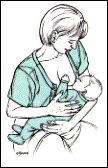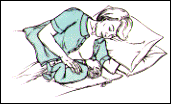Dr. MJ Bazos MD,
Patient Handout
Breast Feeding:
Helpful Hints
What are the benefits of breast
feeding?
Breast feeding has many benefits for your baby.
Breast milk is rich in nutrients. It helps protect your baby against infections.
It also helps prevent your baby from having allergies.
Breast feeding also has benefits for you. It's
clean and simple--you don't have to wash bottles or mix formula. It's cheaper
than using formula. It helps your uterus contract back to normal size after
having been stretched during pregnancy. It delays the return of your periods
(though you shouldn't count on it to prevent pregnancy). And it helps make time
for you to be close to your baby.
How do I begin breast
feeding?
With your free hand, put your thumb on top of
your breast and your other fingers below. Don't touch your areola (the dark skin
around your nipple). This is where your baby's lips will be.
Tickle your baby's lips with your nipple until
your baby opens his or her mouth very wide. Put your nipple all the way in your
baby's mouth and pull your baby's body close to you. This lets your baby's jaw
squeeze the milk ducts under your areola.
When your baby is "latched on" the right way,
both lips should pout out (not be pulled in over his or her gums) and take in
nearly all of the areola. Instead of smacking noises, your baby will make
low-pitched swallowing noises. Your baby's jaw may move back and forth. If you
feel pain while your baby is nursing, he or she is probably not latched on
correctly.
Your baby's nose may be touching your breast
during nursing. Babies' noses are designed to allow air to get in and out in
just such a case. But if you're concerned that your baby can't breathe easily,
you can gently press down on your breast near your baby's nose to give him or
her more room to breathe.
How should I hold my baby while
breast feeding?
You can hold your baby in a number of ways. Your
baby shouldn't have to turn his or her head or strain his or her neck to nurse.

In the cradle position, you put your
baby's head in the crook of your arm. Support your baby's back and bottom with
your arm and hand. Your baby will be lying sideways facing you. Your breast
should be right in front of your baby's face.

The football position consists of tucking
your baby under your arm like a football with his or her head resting on your
hand. Support your baby's body with your forearm. This may be a good position if
you're recovering from a cesarean section.

You can also lie on your side with your
baby facing you. You can use pillows to prop up your head and shoulders. This is
also a good position if you're recovering from a cesarean section or an
episiotomy.
What is the let-down
reflex?
A few seconds to several minutes after you start
breast feeding, you may feel a tingle in your breast and milk may start to drip
from the breast not being used. These are signs that your milk has "let-down."
This means your milk is ready to flow.
This let-down reflex makes breast feeding easier
for your baby. Let-down may also occur if a feeding is overdue, if you hear your
baby cry or even if you think about your baby.
Let-down can be forceful enough to cause your
baby to cough. If this is a problem, you can express some of your milk by hand
before a feeding to bring on the let-down reflex before you start breast
feeding.
What can I do if my nipples get
sore?
It's easier to prevent sore nipples than it is
to treat them. The main thing that causes sore nipples is when your baby doesn't
latch on properly.
If your baby isn't latched on the right way,
you'll need to start over. To take your baby off your breast, first release the
suction by putting your finger in the corner of your baby's mouth between the
gums.
Don't limit the time you let your baby nurse.
This doesn't prevent sore nipples, it just keeps the milk ducts from completely
emptying. This can lead to swelling and pain. Applying crushed ice compresses
before nursing can ease discomfort.
Some women find that rubbing lanolin or vitamin
E oils on their nipples is soothing. If you use lanolin or vitamin E oils, wash
them off before feeding your baby.
Call your doctor if you have a red, sore or
painful area on your breast, if you have painful engorgement, if you have a
fever or if you feel achy. These may be signs of an infection.
|
Preventing/healing sore
nipples
- Make sure your baby is sucking the right way. If
the sucking hurts, your baby's mouth may not be positioned correctly.
- Let your nipples air dry between feedings. Let
the milk dry on your nipples.
- Offer your baby the less sore of your two nipples
first. Your baby's sucking may be less vigorous after the first few minutes.
- Change nursing positions.
- If possible, position any cracked or tender part
of your breast at the corner of your baby's mouth, so that it gets less pressure
during feeding.
- Wash your nipples daily with warm water.
- Avoid bra pads lined with plastic.
- Express milk until your let-down reflex occurs.
This will help make your milk more available so your baby sucks less hard.
- Breast feed often to prevent engorgement
(overfullness of your breast). Engorgement can make it hard for your baby to
latch on.
|
How often should I feed my
baby?
Feed your baby as often as he or she wants to be
fed. This may be about 8 to 12 times a day or more. How often your baby wants to
feed may change over time as he or she goes through growth spurts. Growth spurts
occur at about 2 and 6 weeks of age and again at about 3 and 6 months of age.
Let your baby nurse until he or she is
satisfied. This may be for about 15 to 20 minutes at each breast. Try to have
your baby nurse from both breasts at each feeding. The box below lists the signs
to watch for so you'll know your baby is getting enough milk. If you're nursing
less than eight times a day, be especially aware of these signs.
|
Signs that your baby is getting
enough milk
- Acts satisfied after each feeding.
- Gains weight constantly after the first 3 to 7
days after birth. Your baby may lose a little weight during the first week after
being born.
- Has about 6 to 8 wet diapers a day.
- Has about 2 to 5 or more stools a day at first
and then may have two or less a day. Stools will be runny at first.
|
How can I increase my milk
supply?
If you think your baby needs more milk, increase
the number of feedings a day. It's also important to get plenty of rest and eat
right. Give your body time to catch up to your baby's demands.
Don't start giving your baby formula or cereal.
Your baby doesn't need any solid foods until he or she is 4 to 6 months old. If
you give formula or cereal to your baby, he or she may not want as much breast
milk. This will decrease your milk supply.
What should I
eat?
The main thing is to eat a well-balanced diet
with plenty of calcium. This means eating fruits and vegetables, whole-grain
cereals and breads, meats or beans, and milk and dairy foods like cheese. You'll
need to get enough calories--about 500 more per day than usual--and you'll need
to drink more fluids.
A balanced diet that includes 5 servings of milk
or dairy products each day will give you enough calcium. You can also get
calcium from broccoli, sesame seeds, tofu and kale. Talk to your doctor about
taking extra calcium if you don't think you're getting enough from your diet.
What should I avoid
eating?
If you think a food you're eating bothers your
baby, quit eating it. Caffeine and alcohol can get into your milk, so limit how
much you drink. Drugs--even those you can buy without a prescription--can also
get into your milk. Don't take anything without talking to your doctor first.
Also avoid smoking. Smoking can cause you to make less milk.
Website:



